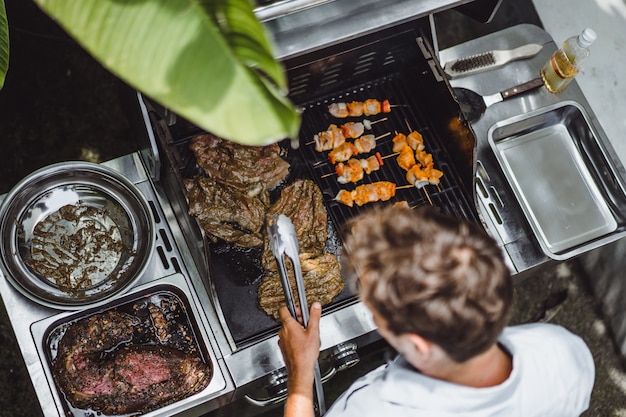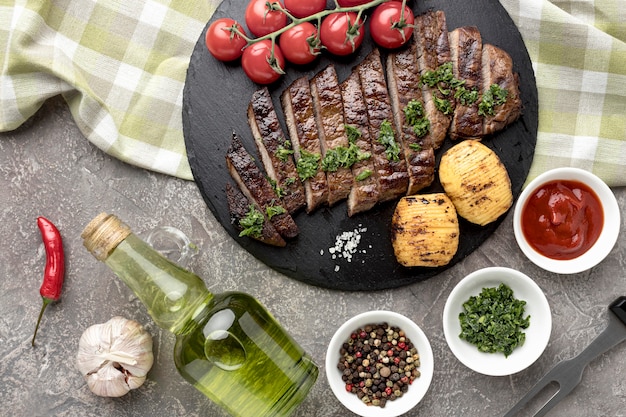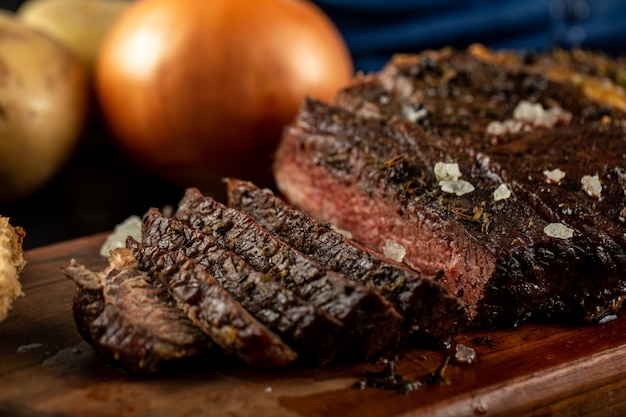Alright, you've got your sights set on a brisket, eh? You've seen those mouthwatering photos, heard the tales of tender, smoky perfection, and you're ready to conquer this barbecue beast. But let's be real, the question on everyone's mind is: how long does it take to cook one of these bad boys?
Well, my friend, I'm here to tell you it's not a quick dash, it's a slow, delicious journey. We're talking about a slow-cooked, low-and-slow, smoke-infused adventure. But don't worry, I'm your guide, ready to walk you through every step, from choosing the right cut to mastering the smoking process, and yes, we'll tackle those burning questions about cooking time. So, grab a cuppa, get comfy, and let's dive into the world of brisket.
(Part 1) Choosing Your Brisket: Picking the Perfect Cut

First things first, we need to talk about the star of the show, the brisket itself. Now, you might be thinking, "Isn't a brisket just a brisket?" Well, not exactly. There are two main cuts, each with its own unique characteristics, and knowing which one to choose is key to achieving brisket nirvana.
The Flat: Lean and Mean
The flat is the leaner of the two cuts, a long, rectangular slab of meat. It's perfect for slicing because it's less fatty and tends to be more tender. Imagine a thick, flavorful steak, and you've got a pretty good idea of the flat.
The Point: Rich and Flavorful
Now, the point is a bit chunkier, a triangular cut with a higher fat content and more marbling. This makes it perfect for pulling, as the fat renders down, adding incredible richness and moisture to the meat.
My Pick: The Point
Personally, I'm a huge fan of the point. That extra fat melts down, creating a symphony of flavor you simply can't replicate with the leaner flat. But if you're after a more lean, delicate taste, then the flat is your best bet.
(Part 2) Prepping Your Brisket: Setting the Stage for Flavor

You've got your brisket, now it's time to get it ready for its smoke-filled transformation. This isn't rocket science, but it's a crucial step in ensuring your brisket sings with flavor.
Trimming the Fat: Getting it Right
The first order of business is trimming the fat. You want a nice, even layer, about a quarter-inch thick. This fat will render down, baste the meat, and contribute to that mouthwatering tenderness. But don't go overboard, remember a little fat is a good thing.
Seasoning Your Brisket: A Symphony of Flavor
Now for the fun part - seasoning! I'm a simple guy, I love a classic salt and pepper rub. It allows the natural flavors of the brisket to shine. But feel free to get creative, adding paprika, garlic powder, onion powder, even a touch of cayenne for a bit of heat. Just remember, don't overdo it – you don't want to mask the meat's natural goodness.
(Part 3) Smoking Your Brisket: The Art of Low and Slow

Ah, here's where the magic happens. This is the heart and soul of brisket cooking, the slow, steady embrace of smoke that transforms ordinary meat into a culinary masterpiece.
Setting Up Your Smoker: The Foundation for Flavor
First, you need to fire up your smoker. Now, I'm a big fan of offset smokers, they create that classic, smoky aroma. But you can use whatever you're comfortable with – pellet grills, charcoal grills, even a good old oven can do the trick. Just remember, you need a consistent source of smoke.
The Smoke: The Soul of Your Brisket
When it comes to smoke, I'm a purist. Hickory and pecan are my go-to choices for that classic, smoky flavor. But don't be afraid to experiment – mesquite, cherry, even applewood can add unique nuances.
The Temperature: Low and Slow for Tenderness
Here's where things get crucial. We're talking low and slow, around 225°F (110°C). This allows the fat to render down and the connective tissues to break down, creating that fall-apart tenderness. It's a slow dance, but one that's well worth the wait.
(Part 4) The Brisket Cooking Time: A Matter of Patience
Now, the million-dollar question: how long does it actually take? It's not a one-size-fits-all answer, my friend. The size of your brisket and your desired level of doneness all play a part.
General Cooking Time: A Starting Point
As a general rule of thumb, plan on cooking your brisket for about 1 hour per pound at 225°F (110°C). But remember, this is just a starting point. Keep an eye on your brisket, it's a marathon, not a sprint.
The Importance of Temperature: The True Gauge
The real indicator of doneness is internal temperature, not just time. You want to reach an internal temperature of 190°F (88°C) for a perfectly tender, juicy brisket. It's like finding the sweet spot for maximum flavor.
The Stall: A Natural Phenomenon
Now, you might encounter what's known as the "stall" – a period where the temperature plateaus. It's caused by the moisture evaporating from the meat, and it's completely normal. Don't fret! Keep the smoker going, and let the brisket do its thing.
(Part 5) The Resting Process: Allowing Flavors to Bloom
Your brisket has reached its target temperature, now it's time for a well-deserved rest. It's like giving the meat a chance to absorb all those delicious juices and become even more tender.
Wrapping Your Brisket: A Moisture Boost
I'm a big fan of wrapping my brisket in butcher paper or foil for the last few hours of cooking. It helps trap the moisture, accelerating the tenderizing process. It's like giving the meat a cozy little blanket.
Let it Rest: Time for Relaxation
After wrapping, remove your brisket from the smoker and let it rest for at least two hours before carving. It might seem like an eternity, but trust me, it's worth it. This resting period allows the flavors to meld and the meat to reach peak tenderness.
(Part 6) Carving Your Brisket: Unveiling the Masterpiece
Finally, the moment you've been waiting for – carving time!
The Right Tools: Getting Equipped for Success
You'll need a sharp carving knife for this job. A good, heavy-duty knife, capable of slicing through tender meat without tearing, is essential.
Slicing the Brisket: The Secret to Tenderness
Here's a little tip I've learned over the years: slice your brisket against the grain. This means slicing perpendicular to the direction of the muscle fibers, resulting in tender, juicy bites.
Point vs Flat: Carving Styles
Remember, carving the flat and the point is slightly different. The flat is sliced into thin, even slices, almost like a steak. The point, on the other hand, is pulled apart, like you would with pulled pork.
(Part 7) Serving Your brisket masterpiece: A Culinary Triumph
You've done it! Your brisket is cooked to perfection, and it's time to enjoy the fruits of your labor.
Classic Sides: The Perfect Accompaniments
A classic brisket deserves classic sides. Think creamy coleslaw, tangy baked beans, creamy potato salad, and a crumbly cornbread.
Don't Forget the Sauce: Personalizing Your Creation
Now, this is where personal preference kicks in. Some people love a good barbecue sauce, others prefer to keep things simple. Either way, make sure you've got a variety of sauces on hand for your guests to enjoy.
(Part 8) Tips and Tricks: Mastering the Art of Brisket
Over the years, I've picked up a few tips and tricks that can help elevate your brisket game:
Don't Overcook: A Delicate Balance
It's easy to overcook a brisket, so keep a close eye on the temperature. Once it hits 190°F (88°C), it's time to wrap it up and let it rest.
Use a Thermometer: The Key to Success
A good meat thermometer is a must-have for checking the internal temperature of your brisket. Don't settle for anything less than a reliable one.
Be Patient: A Virtue in Brisket Cooking
Cooking a brisket takes time. Embrace the process, enjoy the slow, smoky transformation, and don't rush the journey.
Experiment!: Discovering Your Own Style
Feel free to experiment with different rubs, smokes, and sauces. There's no one right way to cook a brisket, so have fun and find what works for you.
(Part 9) Frequently Asked Questions (FAQs)
Here are some common questions I often get about brisket cooking:
What if my brisket isn't done after 1 hour per pound?
No worries, it's better to be cautious and check the internal temperature regularly. It's always better to err on the side of caution.
How can I tell if my brisket is done without a thermometer?
You can use the "probe test" – insert a fork into the thickest part of the brisket. If it goes in easily and the meat feels tender, it's probably done. But I highly recommend using a thermometer for accurate results.
What happens if I overcook my brisket?
An overcooked brisket will be dry and tough. You can try to salvage it by wrapping it in foil and letting it rest for a long time, but it won't be as tender as a properly cooked brisket.
Can I cook a brisket in the oven?
You can cook a brisket in the oven, but it won't have the same smoky flavor as a smoked brisket.
What's the best way to reheat a brisket?
The best way to reheat a brisket is in a slow cooker on low heat. This helps to keep the meat moist and tender.
(Part 10) Conclusion: A culinary journey Worth Taking
There you have it! Your complete guide to brisket cooking. Remember, it's a journey, not a race. Enjoy the process, experiment, and most importantly, have fun! And when you finally slice into that perfectly cooked brisket, you'll be rewarded with a taste of smoky, tender heaven.
Everyone is watching

Perfect Rice Every Time: The Ultimate Guide to Cooking Rice
Cooking TipsAs a self-proclaimed foodie, I've always been a bit obsessed with rice. It's the foundation of countless cuisi...

Prime Rib Roast Cooking Time Chart: Per Pound Guide
Cooking TipsPrime rib roast. Just the name conjures images of lavish dinners, crackling fires, and hearty laughter. It’s ...

The Ultimate Guide to Cooking Asparagus: Tips, Techniques, and Recipes
Cooking TipsAsparagus. The mere mention of this spring delicacy conjures up images of vibrant green spears, crisp and burs...

Ultimate Guide to Cooking the Perfect Thanksgiving Turkey
Cooking TipsThanksgiving. Just the word conjures up images of overflowing tables laden with delicious food, the scent of r...

How Long to Bake Potatoes in the Oven (Perfect Every Time)
Cooking TipsBaked potatoes are a staple in my kitchen. They're incredibly versatile, delicious, and surprisingly easy to m...
